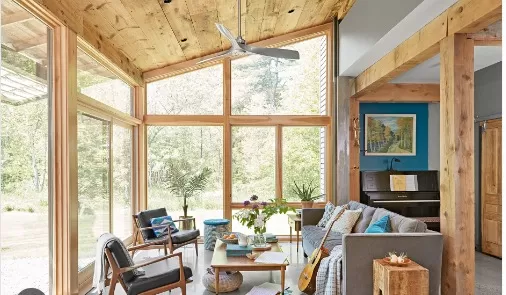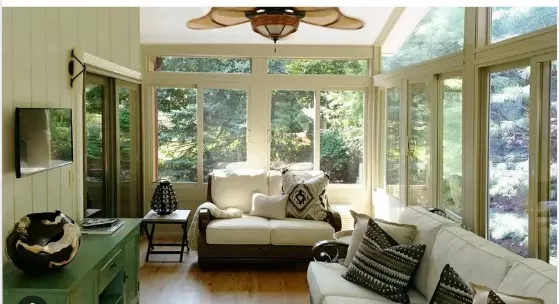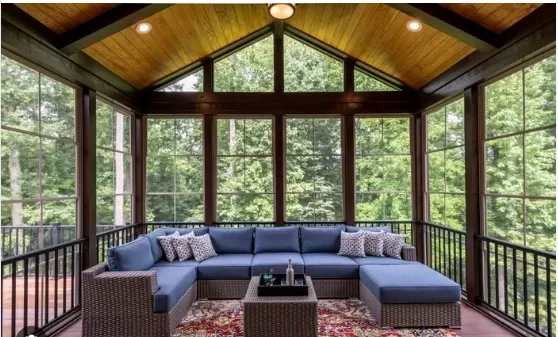Sunroom Explained: Understanding the Definition and Purpose.Sunrooms are highly desirable among homeowners for several reasons. These versatile spaces provide a seamless connection between the indoors and outdoors, allowing you to enjoy natural light and beautiful views while still being protected from the elements. Sunrooms create a bright and inviting atmosphere, making them perfect for relaxation, entertaining guests, or even as a Home Office or gym.
One of the main attractions of sunrooms is their flexibility. They can be enjoyed throughout the year, serving as a cozy retreat in colder months or as a breezy sanctuary during the summer. Additionally, sunrooms can increase the overall square footage of your home without the need for major construction, making them a cost-effective option for expanding your living space.
Before deciding if a sunroom is right for your home, consider factors such as your climate, available space, and budget. Assessing your needs and preferences will help determine the size, design, and functionality of the sunroom. It’s also important to consult with professionals to ensure proper installation and to make informed decisions about materials, insulation, heating, and cooling options.
In conclusion, sunrooms offer a multitude of benefits and can significantly enhance the enjoyment and value of your home. By carefully evaluating your specific circumstances and consulting experts, you can determine if a sunroom is a perfect fit for your needs and create a welcoming space that seamlessly merges the indoors with the outdoors.
Comparing Three-Season and Four-Season Sunrooms

Sunrooms are a popular addition to homes, but not all sunrooms are created equal.
They vary in terms of their usability throughout the year. While three-season sunrooms are suitable for spring, summer, and fall, four-season sunrooms can be used year-round.
Let’s take a closer look at the characteristics and differences between these two types of sunrooms.
Three-season sunrooms are designed as separate rooms, physically segregated from the rest of the house by sliding patio doors or French doors.
They typically feature floor-to-ceiling windows on two or three sides, maximizing natural light. However, one crucial factor that sets them apart is that three-season sunrooms lack climate control systems.
This absence of heating or air conditioning makes them more affordable to build, with costs ranging from $15,000 to $50,000, depending on size, quality, and local construction rates. The presence of a concrete foundation, which can vary as some are built over existing patios or decks, also affects the overall cost.
While they can be built on-site, many people choose to purchase three-season sunroom kits and have them installed by a contractor.
On the other hand, four-season sunrooms are equipped with heating and cooling systems, allowing them to be enjoyed every day of the year.
These sunrooms seamlessly extend the living space of a home and do not have a physical separation from the rest of the house. To accommodate wiring and HVAC ducts, the windows in four-season sunrooms typically do not extend all the way to the floor.
A knee wall, resembling wainscoting, is installed below the windows. Moreover, four-season sunrooms are constructed in compliance with local building codes and often utilize higher-quality materials compared to their three-season counterparts.
For instance, the windows in a four-season sunroom may have features like reduced thermal transfer and multiple panes filled with argon gas. Due to these additional features and enhanced construction, the cost of a four-season sunroom can range from $35,000 to $100,000 or more, depending on size and local construction costs.
In summary, three-season sunrooms are intended for use during spring, summer, and fall, while four-season sunrooms are designed for year-round enjoyment.
The former is physically separated from the rest of the house and lacks climate control, while the latter seamlessly integrates into the home and incorporates heating and cooling systems. The cost of construction varies accordingly, with three-season sunrooms being more affordable, ranging from $15,000 to $50,000, while four-season sunrooms generally cost between $35,000 and $100,000 or more, depending on size and local construction costs.
Considerations for Sunroom Construction
Before embarking on the construction of a sunroom, it is essential to weigh the advantages and potential drawbacks.
The addition of a sunroom can significantly alter your property’s description and increase the value of your home. Let’s explore the pros and cons associated with building a sunroom.
Pros:.
Additional living space: A sunroom provides extra usable space that can serve various purposes, such as an extended family room, a home office, a dining area, a home gym, or a plant nursery.
The versatility of a sunroom allows homeowners to personalize its use according to their needs.
Increased home value: According to Remodeling Magazine’s research in 2013, a sunroom addition costing $73,000 was found to contribute an additional $34,000 to the overall value of the home.
This increase in value can be advantageous if you plan to sell your property in the future.
Versatility: There are no strict rules regarding the usage of a sunroom, offering flexibility and allowing homeowners to explore various possibilities for its purpose.
Cons:.
Increased property taxes: Adding a sunroom that enhances the value of your home often leads to higher property taxes.
Depending on the tax rate in your community, you may experience an annual increase ranging from a few hundred to several thousand dollars.
Higher utility bills: Homeowners who construct a four-season sunroom should expect an increase in their utility bills, as heating and cooling the additional living space requires extra energy consumption.
Privacy concerns: Unless you install shades or curtains, a sunroom may lack privacy, particularly during nighttime when interior lights are visible to passersby.
Potential discomfort during summer: Three-season sunrooms can become excessively warm during hot summers.
However, installing a quality ceiling fan and using removable glass panels can aid in air circulation and alleviate the heat.
In conclusion, constructing a sunroom can offer additional living space, increase home value, and provide versatility in usage.
However, it is essential to consider potential drawbacks such as increased property taxes, higher utility bills, privacy concerns, and the possibility of discomfort during hot summer months. By carefully evaluating the pros and cons, you can make an informed decision regarding the construction of a sunroom that aligns with your preferences and needs.
Decorating Tips for Sunrooms

Decorating a sunroom can be a unique challenge due to its wall-to-wall windows and open space.
However, with the right strategies, you can enhance its aesthetic appeal. Here are some tips to decorate your sunroom effectively:.
Add curtains or shades: Curtains and shades not only provide privacy but also help block direct sunlight during hot summer days.
Opt for sheer fabrics and natural materials to maintain the bright and airy ambiance of the sunroom. Lightweight, light-colored curtain panels can be installed on rods above the windows and pulled back during the day.
Bamboo blinds are another excellent option for individual windows as they can be raised during the day and lowered in the evening.
Soften the concrete floor: If your three-season sunroom has a concrete patio, the floor may feel hard and cold.
To add comfort, incorporate one or more area rugs and choose overstuffed furniture like plush chairs or loveseats. Avoid using bare wicker furniture, as it can make the sunroom look outdated and does little to soften a concrete floor.
Keep furnishings light: Opt for furnishings in light colors like whites, beiges, and pastels to enhance the sunny and airy atmosphere of the sunroom.
Dark trim or furniture colors can detract from this aesthetic. You can add pops of color through accessories like furniture pillows or flower vases.
Incorporate a fireplace: If you have a three-season sunroom, consider adding a fireplace.
Fireplaces not only provide warmth but also add ambiance and comfort on cooler days and evenings. They can be a focal point and enhance the overall appeal of the space.
Don’t skimp on foliage: Green foliage and blooming plants can create a spa-like atmosphere in your sunroom.
Place pots of lush green plants and blooming flowers to add freshness and vibrancy to the space. Vining plants such as bougainvillea or mandevilla can be trained to climb indoor trellises, bringing a tropical feel with their brilliant blossoms.
By following these tips, you can overcome the unique decorating challenges of a sunroom and create a beautiful, inviting space that complements the surrounding natural light and outdoor views.
Choosing the Right Location for Your Sunroom

When considering the addition of a sunroom to your home, it’s important to select the ideal location that aligns with your lifestyle and preferences.
The positioning of your sunroom can greatly impact the experience and benefits it provides. Here are some factors to consider when determining the location of your sunroom:.
East side for sunrise views: Placing the sunroom on the east side of your home allows you to make the most of watching the sunrise while enjoying breakfast.
This location ensures you can start your day with a beautiful view and ample natural light.
North side for filtered light: A sunroom on the north side of your home provides filtered light throughout the day.
This orientation helps avoid the issue of harsh direct sunlight, creating a more comfortable and pleasant environment inside the sunroom.
Traditional placement on the sides or back: Typically, sunrooms are situated on the sides or back of the house.
This placement offers flexibility in design and construction while allowing homeowners to seamlessly extend their living space to connect with the outdoors.
Front placement for curb appeal: Although less common, adding a sunroom to the front of your home is an option to consider.
However, when choosing this location, it’s essential to design the sunroom in a way that complements the style of your home and enhances its curb appeal. Harmonizing the sunroom with the existing architecture will ensure a cohesive and attractive appearance.
By carefully selecting the location for your sunroom, you can optimize the benefits and enjoyment it brings to your daily life.
Whether you prioritize sunrise views, filtered light, traditional placement, or front aesthetics, finding the perfect spot will enhance your overall sunroom experience and enrich your home.
*The information is for reference only.